16 unique roofs from all over the globe
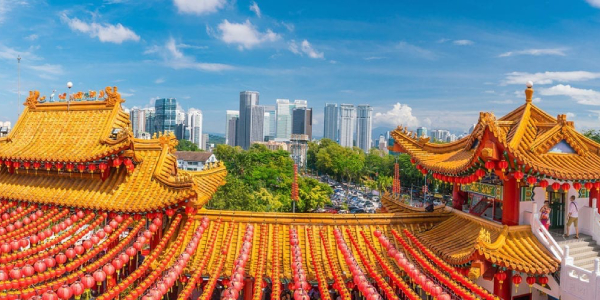
By IKO Industries.
From modern green roofs to traditional tile, beautiful roofs come in all shapes and sizes.
Across the globe there are a myriad of amazing different cultures and landmarks. But one thing that is a commonality is the need for shelter from the elements, no matter what climate you live in. And so, roofs can be found on everything from an everyday home to stunning cultural landmarks. These roofs display more than a common need for functionality, they also embody their architect’s personal and cultural style and the builder’s masters of roofing technology.
IKO knows that roofs can shape history in a variety of ways. We have collected a shortlist of roofs around the world that have broken world records, seen some of history’s biggest shifts and inspired roof structure design for centuries after they were built. One of the most interesting things to examine in these beautiful roofs is what materials are used. This list includes everything from glass, gold, reeds, ceramics to more. All of this builds a story into each roof, based in unique color, texture and symbolism.
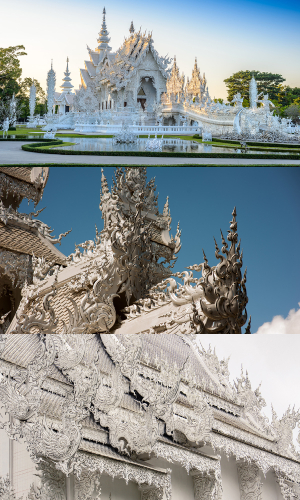
1 - Wat Rong Khun
Location: Thailand
Style: Contemporary and traditional Buddhist
Materials: Specialized plaster, glass and mirrors
Wat Rong Khun is known in English as the White Temple. It is a personal project of artist and devout Buddhist Chalermachai Kositpipat. He began building the structure in 1997 and is still expanding it.
Each element of the temple is full of intricate, hand-sculpted detail that Kositpitpat and his team labor over. The roof is no exception, with traditional religious elements, such as depictions of Buddha, hidden among the flourishes. There are also mythical creatures and modern pop culture figures sculpted throughout the several buildings that make up the temple.
Why make the structure all white? Kosipitpat says the white symbolizes Buddha’s purity. The glass and mirrors embedded in the sculptures represent Buddha’s wisdom. While the temple is a very popular tourist attraction, monks also practice Buddhism in its halls.
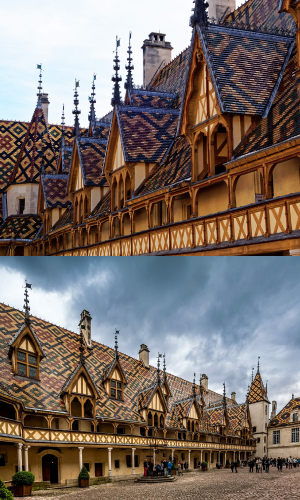
2 - Hospice de Beaune
Location: Beaune, France
Style: Flamboyant Gothic
Materials: Traditional glazed tile
Built in the 15th century as a charity hospital for the poor of Beaune, this building now serves as a hotel and museum. To continue with the building’s charitable tradition, the owners hold an annual charity wine auction here.
The carefully arranged brown, red, yellow and green tiles of this roof create striking geometrical patterns amid the building’s dormers and turrets. In the past, owning a building with such a roof became a status symbol for French princes and wealthy city dwellers. Since then, Burgundy (Bourgogne), France has become famous for this type of roofing.
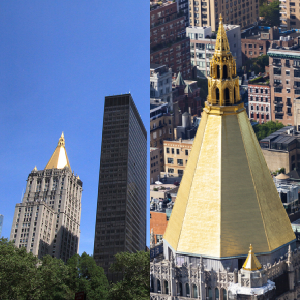
3 - New York Life Building
Location: New York, USA
Style: Neo-Gothic
Material: Gold leaf tiles
The New York Life Building has reigned in New York with a golden crown since 1928. The influential designer Cass Gilbert is the mastermind behind the golden cap. It is an 88-foot-tall octagon, covered in thousands of 22-carat gold leaf tiles.
This exquisite roof is, no surprise, flashed with copper. Both the copper flashing and gold tiles do become tarnished by time, but New York Life continues to clean and restore the roof regularly.
In fact, for the company’s 140th anniversary, the company lit up the building at night, making an impressive statement on the New York skyline.
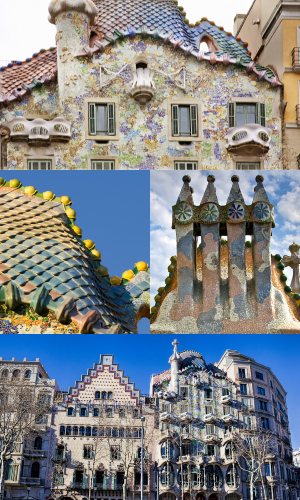
4 - Casa Batllo
Location: Barcelona, Spain
Style: Modernist
Materials: Stone, glass, ceramics
This fantastical, vibrant roof is part of Antoni Gaudi’s masterpiece, the Casa Batllo or House of Bones. It has been listed as a UNESCO World Heritage site and is a very popular tourist attraction in Barcelona.
Though Gaudi never explained how he envisioned the building, the roof is widely believed to represent the back of a dragon. The iridescent ceramic tiles are the dragon’s scales, there is a window for the dragon’s eye and the ridge of the roof is the dragon’s spine.
While some believe that the spire represents the dragon’s tail, others believe it represents the mythical spear of Saint George. As the patron saint of Gaudi’s hometown, Saint George slew a dragon to save a princess.
No matter your interpretation of the building, the colorful sparkling ceramic tiles and fantastical shapes of this unique roof invite you to dwell in your own imagination as you walk on it.
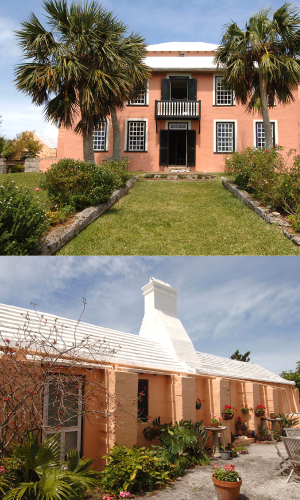
5 - Verdmont
Location: Smith’s Parish, Bermuda
Style: Bermudian
Materials: Limestone
Once a mansion, now a museum, the Verdmont is an excellent example of the vivid Bermudian roof style. As there are no sources of fresh water on the island, Bermudians use their roofs to collect rainwater. With this purpose in mind, they developed a stepped white roof style, cut from limestone and covered with either lime mortar or paint.
Further, because the roof is white, the trim on much of the Verdmont is black, which is a very unusual stylistic choice. The former Verdmont slave quarters, pictured below, demonstrate that even Bermudian chimneys are cut from stone and painted that refreshing white.
More recent Bermudian buildings, modeled after this iconic style, choose other pastel colors for their facades. As a result, walking down Bermuda’s streets is a colorful architectural experience.
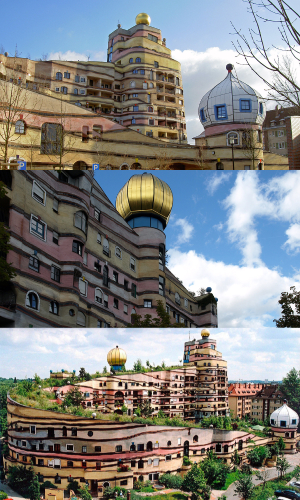
6 - Waldspirale
Location: Darmstadt, Germany
Style: Green roof with Russian elements
Materials: Recycled concrete
Waldespirale is German for “forest spiral.” This eccentric apartment building was named for its huge “U” shaped green roof. Some of the lucky inhabitants get their own slice of the roof garden, which is deep enough to grow trees, grass and vegetables.
According to a documentary on the building, the building’s artist, Friedensreich Hundertwasser, wanted to connect people with nature. He believed that green roofs, or those roofs that support plant life, would become the norm for all buildings.
His colorful vision, complete with Russian-style onion towers and wavy walls, ensures that the building looks beautiful even in the winter.
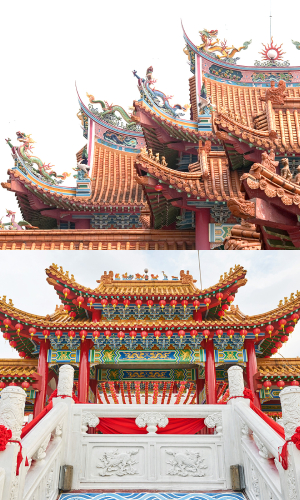
7 - Thean Hou Temple
Location: Kuala Lumpur, Malaysia
Style: Confucian, Buddhist and Taoist influences
Materials: Traditional glazed clay roofing tiles
In Chinese tradition, Thean Hou is a goddess, called the heavenly mother, who protects fisherman. To honor her, the Hainanese people of Malaysia built this impressive temple in 1981. The tiered roof style is called a pagoda and it's typical of many religious buildings in Asia. The pointed corners may have originally meant to protect the outer wooden beams of the building from the rain.
The Than Hou Temple is an unusual example of this style, with six tiers instead of the traditional three. Each tier is covered in traditional Chinese clay roofing tiles, which are pressed into a semi-circle shape on a wooden mold, dried and glazed. The edge tiles have angled faces to shed water better and, in this case, are pressed with detailed molds to add even more texture.
The corners of several of the eaves support ornately carved dragons. Their vibrant color and sense of movement inspires worshipers as they light incense and let the smoke rise to the dragons’ level.
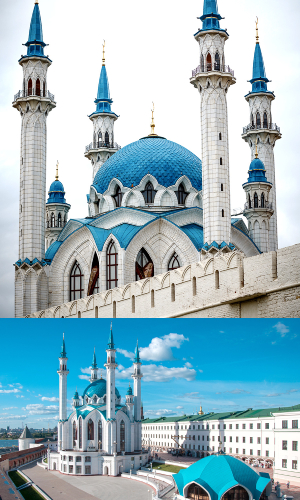
8 - Kul-Sharif Mosque
Location: Kazan, Russia
Style: Tartar and Russian
Materials: Glazed ceramic tile
The mosque was rebuilt in 2005, after being destroyed centuries before, in 1552, by the Russian army led by Ivan the Terrible. It now serves as a museum, library, place of worship and memorial. Visitors have compared the mosque to a Disney castle. Some historians believe it may have even influenced the famous St. Basil’s Cathedral.
The teal blue roof makes quite a statement against the white stone and concrete used for the rest of the facade. The central dome and the four minarets are topped with gorgeous golden Islamic half-moons. The Kul-Sharif Mosque demonstrates that sometimes simplicity makes for the most striking roofs.
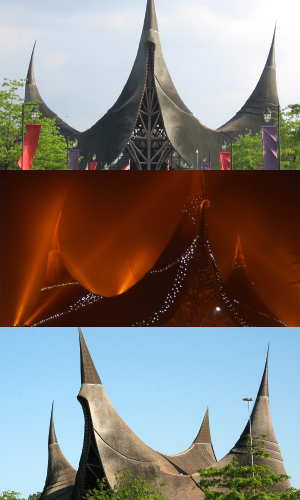
9 - House of Five Senses
Location: Kaatsheuvel, Netherlands
Style: Rumah Gadang
Materials: Reeds
The Efteling circus in the Netherlands was inspired by the traditional thatched roof style of Indonesia when they made this incredible roof. This building, the House of the Five Senses, is the largest example of this kind of roofing in the world.
A traditional thatched roof from Indonesia uses layers of reeds, supported by battens, to surge up to a delicate point on either side. This particular roof has five points, one for each of the senses. Plus, each point is inlaid with lights, to show off the shape to night-time circus goers.
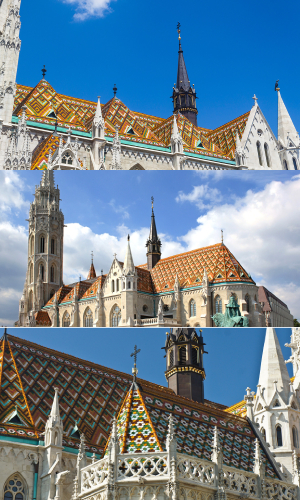
10 - Matthias Church
Location: Budapest, Hungary
Style: Florid Late Gothic
Materials: Zsolnay ceramic tiles
The original Matthias Church was built in 1255. Over the years it decayed and was rebuilt several times by those from several different religions. Kings held their coronations in its halls. At other times the church was in serious disrepair. Legend says a wall in the church collapsed, revealing a long-hidden statue of the Madonna, which shamed an invading army into surrendering.
In 1896, the diamond patterned ceramic roof tiles were added by architect Frgyes Schulek. He also added gargoyles and restored other elements of the church to its original Gothic style.
The roof’s bright teal, orange, red, green tiles make intricate patterns on the rooftop including flowers, chevrons and crosses. The skill of the tile installers must have been immense. Between the extraordinary roof and the other incredible architectural details of this building, the church is awe-inspiring.
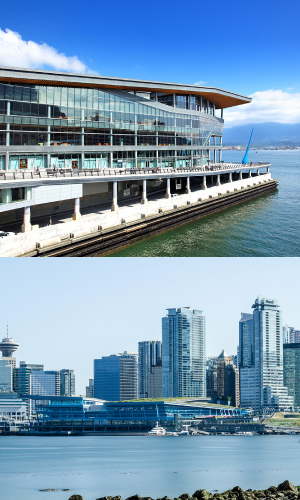
11 - Vancouver Convention Center
Location: Vancouver, Canada
Style: Green Roof
Materials: Vegetation
Behold the biggest non-industrial green roof in North America. It spans across six acres and is planted with over 400,000 grasses and other plants native to Vancouver. Four European honeybee hives are living on the roof. Plus, an extension of the building houses a marine habitat to help revive the ocean life nearby.
A green roof insulates and protects from summer heat like no other. The Vancouver Convention Center houses a lot of people though, so for its seawater heating and cooling system it also takes advantage of seawater to produce cooling for the building during warmer months and heating in cooler months. In no small part due to its extraordinary roof, the Convention Centre has been called the world’s most eco-friendly meeting venue.
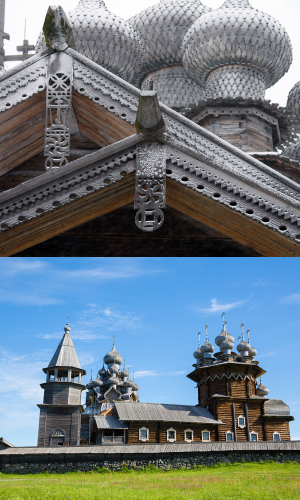
12 - Kizhi Pogost Church
Location: Kizhi Island, Russia
Style: 18th century Russian
Materials: Wood
This sparkling silver roof sits atop the world’s largest wholly wooden building. The Kizhi Pogost Church’s roof was constructed out of Scot’s pine and spruce in the 18th century. Fire, lightning and time have worn at the wood, but the community has continued to repair it.
The 22 roof domes, called cupolas, are the only part of the building with nails. Every wooden shingle is finely textured and there are over 60,000 of them. Legend has it that the man, Master Nestor, who built the church used a single axe throughout the whole project. When it was done, he threw the axe in the lake, saying “there was not and will be not another one to match it.” He was talking about the building.
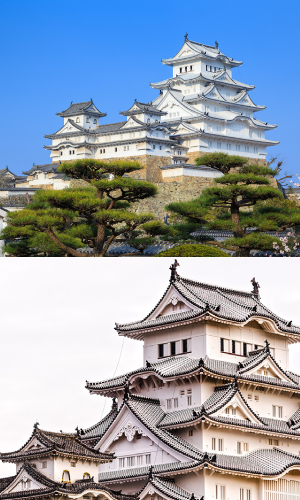
13 - Himeji White Heron Castle
Location: Himeji, Japan
Style: Feudal Japanese
Materials: Wood, tile, plaster
The White Heron Castle is so named because it reminds visitors of a white egret (a kind of heron) taking off into the sky. The building looks quite modern, but only because it has been meticulously maintained and renovated over the years. It was first built in 1609, during Japan’s feudal period.
The new tiles are still made by traditional methods. The black edge tiles are carefully placed and pressed down to make the rippling texture.
The roof tiles had once faded to grey, but they were restored to a brilliant white most recently in 2010. In the image above you can see the faded grey tiles on the left and the bright white restored tiles on the right.
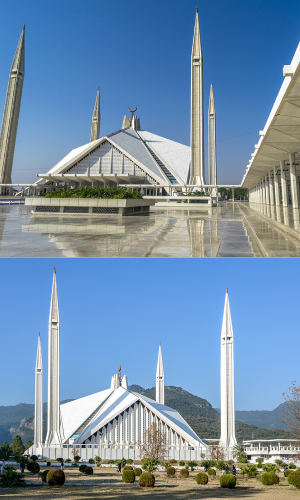
14 - Faisal Mosque
Location: Islamabad, Pakistan
Style: Contemporary
Materials: Concrete, marble
The newest trends in Islamic architecture have focused on new roof shapes, in part thanks to the Faisal Mosque. Instead of the traditional dome, the mosque’s geometrical center is inspired by a Bedouin tent. The roof’s exterior is made of polished marble, with a unique texture that makes it look like large stone slabs.
A competition was held to choose the design for the building. Turkish architect Vedat Dalokey submitted the winning design and King Faisal of Saudia Arabia funded the project. Those in the Islamic community who have traditional tastes took some time to warm up to the design, but the mosque is now widely acclaimed for its beauty.
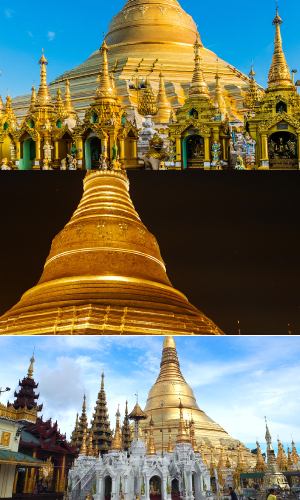
15 - Shwedagon Pagoda
Location: Yangon, Myanmar
Style: 6th to 10th century Buddhist
Materials: Bricks, gold
This Buddhist shrine has been standing for centuries, prompting visitors to wonder how people of limited technology could have collected such wealth. Today the shrine is hailed as the best place for tourists to visit in Myanmar.
The traditional layered roof on the left is a pagoda. The tall, golden point of the roof to the right is called a stupa. The structure was built of brick, but real gold plates cover its entire 99-meter length. At the very point of the roof is a massive diamond.
The public is not allowed to enter the main stupa, but legend has it that monks that guard the stupa also guard eight hairs from Buddha’s head and other prized relics.
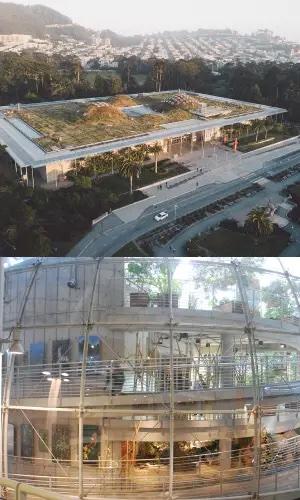
16 - California Academy of Sciences
Location: San Francisco, California, USA
Style: Green roof
Materials: Glass, solar panels, vegetation
The rolling green roof at the California Academy of Sciences looks both high-tech and natural at the same time, an impressive feat. 1.7 million trays hold the vegetation, a variety of native plants that provide habitat for local insects and animals.
Beneath the seven raised domes of this green roof are aquariums, planetariums and a rainforest all designed for research, learning and exploration. Plus, the roof keeps the building temperature regulated and captures 100 percent of the excess storm water that pours onto it. This design proves that a cutting-edge roof isn’t just about looks. Roofs can also contribute to our knowledge about the world around us.
Ever since humans constructed buildings, we have developed unique roofs to shelter them. Across the world, different societies cultivated roofing traditions that speak of their culture, climate, values, art and religion. Over time, new roofing techniques and materials have pushed whole societies in new directions.
While once religious figures and organizations built the most impressive roofs, increasingly private companies, governments and even homeowners are harnessing roofs to meet their needs. The roofs on this list that were most recently constructed are all geared to a purpose. They save energy, connect us with nature, entertain us and help us learn something new. Of course, they accomplish all that while being beautiful and sheltering us from the elements. Roofs will always protect us, but they have the potential to do so much more.
At IKO, we look forward to the future of roofing and hope to inspire you to share it with us. Keep your eye on the skyline. You never know what fantastic roofs will pop up next.
Original article source: IKO
Learn more about IKO in their Coffee Shop Directory or visit www.iko.com/na/.













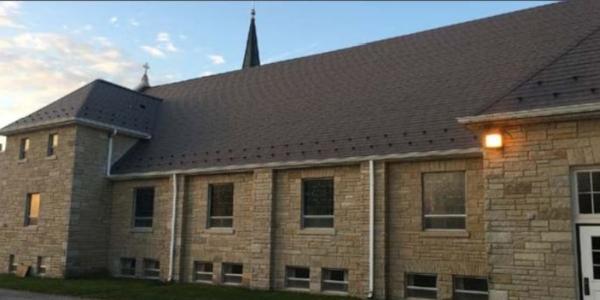
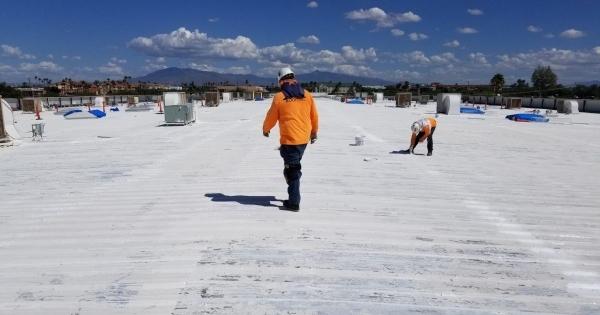







Comments
Leave a Reply
Have an account? Login to leave a comment!
Sign In